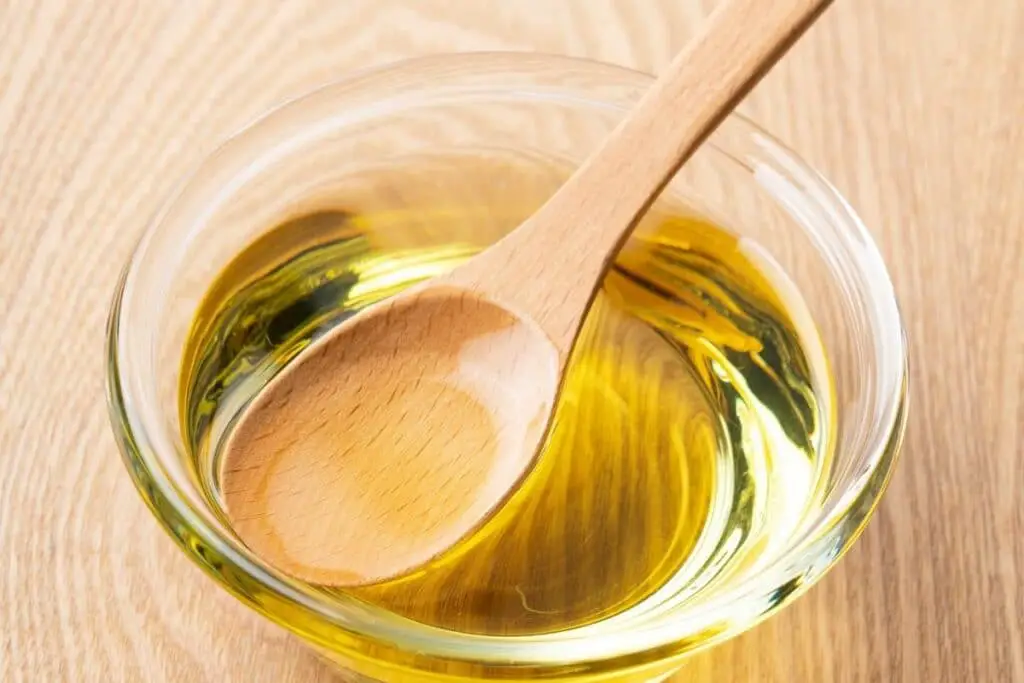In cooking and baking, you can use ingredients such as olive oil, sunflower oil, coconut oil, butter, etc. instead of canola oil. We also explain the pros and cons of each substitute, such as flavor, smoke point, health benefits, and availability, below.
For many home cooks and restaurants, canola is the go-to oil for cooking, deep-frying, and baking due to its neutral flavor and versatility. It is widely available, can be used in sweet bakes, savory dishes, and even as a raw component in salad dressings.
If you’re out of canola mid-cook and left in a pinch, there are many other alternatives you can use instead. We’ve rounded up the best replacements to save your dish.
In addition to the best canola oil substitute, we’ll also provide you with a little information on what canola is so that you can choose the best replacement according to the type of dish you are cooking.
What Is Canola Oil?
Canola oil is made from a certain variety of rapeseed that has been specifically bred to have very low levels of erucic acid as opposed to the natural variety which contains very high acid levels. Rapeseed comes from a plant with small yellow flowers and is part of the mustard and cabbage family.
Keep in mind that although made from a similar variety of plants, canola and rapeseed oil have very different properties and are not the same product.
The seeds are cleaned, heated, and rolled for oil extraction after which refining and processing take place. Oils that have been refined generally have a neutral flavor, clear appearance, and bland odor.
Although this vegetable oil is mostly known for its application in cooking it is widely used in non-food products such as candles, newspaper ink, and lipstick.
Canola Smoke Point
It is important to choose an alternative with a similar smoke point when choosing a substitute for canola oil, especially when frying foods. When oil starts smoking (also referred to as the smoking point) it is a sign that chemical changes are taking place and the oil is starting to break down.
Chemical changes that happen at this point can result in a bitter taste. The smoking point can range from 325 °F to 520 °F depending on the oil. Make sure the oil smoke point can handle the method of cooking you are using.
Refining removes impurities that can cause the product to smoke as well as free fatty acids. For this reason, refined oils have a higher smoke point and are more suitable for sauteing, stir fry, and deep-frying. Oils that are unrefined should not be heated. These include flaxseed and walnut varieties.
Home cooking methods such as roasting, pan-frying, and stir-frying are generally done between 250 °F to 400 °F. Oils that are suitable for cooking at high temperatures with a smoke point of 400˚F and higher include canola, sunflower, safflower, peanut, and grapeseed oil.
Do not buy bulk quantities that you will not use within 12 months. The quality will decline due to light, air, and heat exposure causing it to go rancid. It is, therefore, best to store oil in a dark, cool pantry cupboard or kitchen cabinet.
Best Canola Oil Substitutes
All substitutes can be replaced in equal measures.
1. Sunflower Oil
Sunflower oil is a great substitute choice considering that it has very similar properties to canola. The oil is derived from sunflower seeds using a similar method of cleaning, heating, and pressing the seeds for extraction after which it is refined and processed.
The oil’s neutral flavor and high smoking point at 450 °F make it very versatile for pretty much any cooking method and flavor profile.
Best used for: Various frying methods, oven roasting, baking, and salad dressing
2. Safflower Oil
Made from pressed safflower plant seeds, this oil is practically flavorless and has a very high smoking point at 510 °F. This makes it incredibly versatile, suitable for most cooking methods and flavor profiles.
It can be used in delicately flavored sweet baked goods and savory dishes since it won’t influence the flavor of your recipe. Due to its high smoking point, it is also less likely to cause any bitterness when heated at high temperatures.
Best used for: Various frying methods, oven roasting, baking, and salad dressings
3. Cottonseed Oil
Although not as well known as other oils, cottonseed oil is available at some larger grocery stores and can be found quite easily online. Its neutral taste and high smoke point make it a great product for dressings, sauces, mayonnaise, and meat marinades as well as various cooking, frying, and baking methods.
Best used for: Various frying methods, oven roasting, baking, sauces, and salad dressings
4. Peanut Oil
With its high smoke point at 450 °F, peanut oil is an ideal alternative for shallow- and deep-frying, sauteing, and stir-frying. If you do decide to use peanut oil as a replacement keep in mind that it does have a strong peanut taste that will be identifiable in your dish and can overpower other delicate flavors.
The nutty flavor can be delicious in stir fry and roast vegetables, but might not be favorable in baked items. Avoid peanut oil if you are cooking for anyone with nut allergies.
Best used for: Various frying methods and oven roasting
5. Soybean Oil
Similar to cottonseed oil, soybean oil is a more unusual substitute for home cooking. It is available at many large grocery stores or online. When you purchase it for cooking, keep in mind that you should get the refined version as this has a high smoke point and won’t impart a bitter taste when heated.
Refined soybean oil has a neutral flavor which makes it ideal for anything from baked goods and dressings to stovetop cooking and roasting.
Best used for: Various frying methods, oven roasting, baking, sauces, and salad dressings
6. Avocado Oil
Avocado oil is known to be a healthy option although it does have a distinct taste that may alter the taste of your dish and overpower other delicate flavors. Both refined and unrefined avocado oil has a high smoke point making it ideal for all types of cooking, roasting, and using raw in dressings.
Best used for: Various frying methods, oven roasting, and salad dressings
7. Coconut Oil
Coconut oil is available in a refined or unrefined version. Refined coconut oil has a higher smoking point which makes it more suitable for cooking. It is best used for sauteing or baking, however, it does have a strong coconut taste which will most likely affect the flavor of your dish. It can be added to smoothies and sweet dishes but is not a good option for frying.
Best used for: Sauteing and baking
8. Almond Oil
Almond oil is another option known for its health properties. This oil can add a lovely nutty note to baked items or dressings, however, the distinct flavor can change the taste of what you are cooking so keep that in mind.
This oil is not a good option for frying or sautéing and is best for raw recipes, salad dressings, drizzling over bread or vegetables, and can be used for baking.
Best used for: Baking and raw applications such as dressings
9. Olive Oil
Olive oil is a popular culinary oil known for its health benefits but can be on the pricier side. Olive oil has a low smoking point at only 210 °F which makes it a poor choice for frying. It is best used for salad dressings, dips, and to drizzle over vegetables or bread. It can also be used for low-temperature sautéing as well as oven roasting.
Olive oil cake is the ideal example of using this oil in baked applications. When using it in baked recipes other than olive oil cake, keep in mind that it does have a strong flavor that will affect the overall taste of your baked goods which may not pair well with a sweet recipe.
Extra virgin olive oil has a stronger taste than virgin olive oil, so you may want to stick to the latter for better versatility if you plan to use it in a variety of dishes.
Best used for: Sauteing, roasting, baking olive oil cakes, and raw applications such as dressings or dips. Not suitable for frying.
10. Corn Oil
Corn oil is made from the germ of corn kernels and is somewhat cheaper than other oils. Its mild taste and high smoke point at 450 °F make it a great substitute for canola when frying and cooking at high temperatures. It won’t affect the flavor of your dish which means it can be used in almost any application, sweet or savory.
Best used for: All types of frying, oven roasting, baking, sauces, and salad dressings
FAQs
Refined canola oil has a smoke point of 400 °F.
General cooking oil prices have increased lately, but especially that of canola and rapeseed oil due to the drought in Canada that has affected crop production. Chinese purchase trends which were initiated as a result of their crop issues have also largely affected the market.
Regular oil production involves heating of seeds prior to extraction of the oils which are then processed and refined. Cold-pressed oils are obtained by natural means by extracting the oils at room temperature without the application of heat or chemical treatments.
Cold-pressed oils are therefore unfiltered and minimally processed allowing them to offer the best nutritional value, however, they have a shorter shelf-life than their processed counterparts.
Cold-pressed oils also have a lower yield which often means they are more expensive. Since they are unrefined it means they have a low smoke point and are best used in raw applications or very low-temperature cooking.
A suitable substitute for canola or vegetable oil in cooking and baking is olive oil, which provides a similar neutral flavor and can withstand medium to high heat.
Conclusion
Canola oil is a fantastic versatile product that can be used with all types of cuisines, cooking methods, and flavor profiles. If you have run out of canola or are looking for an alternative option to try, there are a number of other vegetable oils to choose from.
For deep frying and high-temperature cooking corn oil, safflower, sunflower, and peanut oil are the best alternatives. For baking, sunflower and safflower are also great options as well as soybean and cottonseed oil.
When it comes to salad dressings, dips, and drizzling over vegetables, oils with great health properties in their raw form include avocado and olive oil. If you want to add a different flavor to your dish try coconut or peanut oil which will give your usual recipe a bit of a twist.
Whichever option you use, make sure the smoke point of the specific oil matches your cooking method to maintain the best flavor.
See more:
*image by sai0112/depositphotos









